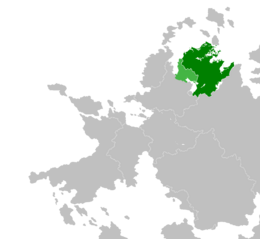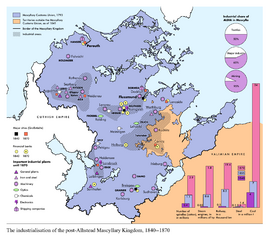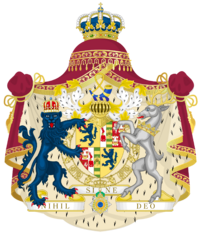Mascyllary Kingdom: Difference between revisions
mNo edit summary |
mNo edit summary |
||
| (6 intermediate revisions by the same user not shown) | |||
| Line 4: | Line 4: | ||
|conventional_long_name = Mascyllary Kingdom | |conventional_long_name = Mascyllary Kingdom | ||
|common_name = Mascylla | |common_name = Mascylla | ||
|era = | |era = 1793–1847<br>1847–1923 | ||
|status = | |status = Kingdom | ||
|status_text = < | |status_text = {{bulleted list|{{wp|Sovereign state|Sovereign kingdom}} <small>(1793–1923)</small>|In {{wp|personal union}} with the [[Valimian Empire]] <small>([[Kingdom of Welsbach]] only, 1793–1922)</small>}} | ||
|empire = <!-- The empire or country to which the entity was in a state of dependency --> | |empire = <!-- The empire or country to which the entity was in a state of dependency --> | ||
|government_type = {{wp|Federal monarchy|Federal}} {{wp| | |government_type = {{wp|Federal monarchy|Federal}} {{wp|absolute monarchy}} <small>(1793–1847)</small><br>{{wp|Federal monarchy|Federal}} {{wp|parliamentary system|parliamentary}} {{wp|constitutional monarchy}} <small>(1847–1923)</small> | ||
<!-- Rise and fall, events, years and dates --> | <!-- Rise and fall, events, years and dates --> | ||
<!-- only fill in the start/end event entry if a specific article exists. Don't just say "abolition" or "declaration" --> | <!-- only fill in the start/end event entry if a specific article exists. Don't just say "abolition" or "declaration" --> | ||
| Line 23: | Line 23: | ||
|event2 = Constitution adopted | |event2 = Constitution adopted | ||
|date_event2 = 17 April 1796 | |date_event2 = 17 April 1796 | ||
|event3 = [[ | |event3 = [[Mascyllary Revolution of 1847|October Revolution]] | ||
|date_event3 = | |date_event3 = 25 October 1847 | ||
|event4 = [[Treaty of Lehpold]] | |event4 = [[Treaty of Lehpold]] | ||
|date_event4 = 10 March 1917 | |date_event4 = 10 March 1917 | ||
| Line 39: | Line 39: | ||
|flag_p1 = Elbgau Confederacy flag.png | |flag_p1 = Elbgau Confederacy flag.png | ||
|image_p1 = <!-- Use: [[File:Sin escudo.svg|20px|Image missing]] --> | |image_p1 = <!-- Use: [[File:Sin escudo.svg|20px|Image missing]] --> | ||
|p2 = Kingdom of | |p2 = Kingdom of Adwinia | ||
|flag_p2 = FlagAdwhin.png | |flag_p2 = FlagAdwhin.png | ||
|p3 = Kingdom of Holnia | |p3 = Kingdom of Holnia | ||
| Line 73: | Line 73: | ||
|s15 = | |s15 = | ||
|s16 = | |s16 = | ||
|image_flag = | |image_flag = Standard of the Mascyllary Kingdom (1793).png | ||
|flag_alt = | |flag_alt = | ||
|image_flag2 = | |image_flag2 = MascyllaFlagIII.png | ||
|flag_alt2 = | |flag_alt2 = | ||
|flag = <!-- Link target under flag image. Default: Flag of {{{common_name}}} --> | |flag = <!-- Link target under flag image. Default: Flag of {{{common_name}}} --> | ||
|flag2 = <!-- Link target under flag2 image. Default: Flag of {{{common_name}}} --> | |flag2 = <!-- Link target under flag2 image. Default: Flag of {{{common_name}}} --> | ||
|flag_type = | |flag_type = Top: [[Flag of Mascylla|Royal Standard]] (1793 version)<br>Bottom: [[Flag of Mascylla|Flag]] (1847–1923) | ||
|flag2_type = <!-- Displayed text for link under flag2. Default "Flag" --> | |flag2_type = <!-- Displayed text for link under flag2. Default "Flag" --> | ||
|image_coat = Mascyllary Kingdom coat of arms.png | |image_coat = Mascyllary Kingdom coat of arms.png | ||
| Line 86: | Line 86: | ||
|symbol_type = <!-- Displayed text for link under symbol. Default "Coat of arms" --> | |symbol_type = <!-- Displayed text for link under symbol. Default "Coat of arms" --> | ||
|symbol_type_article = <!-- Link target under symbol image. Default: Coat of arms of {{{common_name}}} --> | |symbol_type_article = <!-- Link target under symbol image. Default: Coat of arms of {{{common_name}}} --> | ||
|image_map = [[File:Mascyllary Kingdom on the eve of the Great War.png| | |image_map = [[File:Mascyllary Kingdom on the eve of the Great War.png|260px]] | ||
|image_map_alt = | |image_map_alt = | ||
|image_map_caption = The Mascyllary Kingdom on the eve of the Great War in green, territories lost after | |image_map_caption = The Mascyllary Kingdom on the eve of the Great War in green, territories lost after the [[Alhstead Wars]] (1832–1841) in light green | ||
|image_map2 = [[File:Mascylla_map_1793.png| | |image_map2 = [[File:Mascylla_map_1793.png|260px]] | ||
|image_map2_alt = | |image_map2_alt = | ||
|image_map2_caption = | |image_map2_caption = Internal composition of the Mascyllary Kingdom; the Kingdom of Aldia in light grey | ||
|capital = | |capital = [[Lancaide]] <small>(1793–94)</small><br>[[Königsreh]] <small>(1794–1923)</small><br>[[Augusthal]] <small>(unofficially, 1793–1830)</small> | ||
|capital_exile = <!-- If status="Exile" --> | |capital_exile = <!-- If status="Exile" --> | ||
|national_motto = ''Vereint in Blut und Schwur''<br><small>"United in blood and oath"</small><br>''Nihil sine Deo''<br><small>"Nothing without God" ({{wp|Latin language|Cambran}})</small> | |national_motto = ''Vereint in Blut und Schwur''<br><small>"United in blood and oath"</small><br>''Nihil sine Deo''<br><small>"Nothing without God" ({{wp|Latin language|Cambran}})</small> | ||
| Line 155: | Line 155: | ||
}} | }} | ||
The '''Mascyllary Kingdom''' ({{wp|German language|Hesurian}}: ''Maskillisches Königreich''), also unofficially known as the '''Kingdom of Mascylla''' ({{wp|German language|Hesurian}}: ''Königreich Maskillien'') or simply '''Mascylla''', was the [[Mascyllary people|Mascyllary]] {{wp|nation state}} that existed from the [[War of the Five Kings|unification of Mascylla]] in 1793 until [[Mascyllary Revolution|the abdication and execution]] of [[Monarchy of Mascylla|King Louis I]] in 1923. The Mascyllary Kingdom was composed of 20 constituent states, most of them were ruled by a {{wp|dynasty|royal family}} (referred to as the ''Reichsfürste''); these included five {{wp|kingdom|kingdoms}}, three {{wp|grand duchy|grand duchies}}, five {{wp|duchy|duchies}}, three {{wp|principality|principalities}}, and four {{wp|city state|independent cities}}. | The '''Mascyllary Kingdom''' ({{wp|German language|Hesurian}}: ''Maskillisches Königreich'', <small>pronounced:</small> {{wp|Help:IPA/Standard German|[ˈmaski:lɪʃəs ˈkø:nɪgʁaɪ̯ç]}}), also unofficially known as the '''Kingdom of Mascylla''' ({{wp|German language|Hesurian}}: ''Königreich Maskillien'') or simply '''Mascylla''', was the [[Mascyllary people|Mascyllary]] {{wp|nation state}} that existed from the [[War of the Five Kings|unification of Mascylla]] in 1793 until [[Mascyllary Revolution|the abdication and execution]] of [[Monarchy of Mascylla|King Louis I]] in 1923. The Mascyllary Kingdom was composed of 20 constituent states, most of them were ruled by a {{wp|dynasty|royal family}} (referred to as the ''Reichsfürste''); these included five {{wp|kingdom|kingdoms}}, three {{wp|grand duchy|grand duchies}}, five {{wp|duchy|duchies}}, three {{wp|principality|principalities}}, and four {{wp|city state|independent cities}}. | ||
The [[War of the Five Kings|Treaty of Langquaid]], signed on 18 May 1793 to end the fighting of the [[War of the Five Kings]], belatedly concluded the unification and establishment of Mascylla; [[Monarchy of Mascylla#List|Lucas I]], [[Kingdom of Aldia|King of Aldia]], was {{wp|elective monarchy|elected}} as {{wp|absolute monarchy|absolutist}} [[Monarchy of Mascylla|Mascyllary King]] (''Maskillischer König'') in Langquaid on 23 May. Based on the hegemony of the [[House of Ahnern]] over Mascylla as a whole and the exclusion of [[Kingdom of | The [[War of the Five Kings|Treaty of Langquaid]], signed on 18 May 1793 to end the fighting of the [[War of the Five Kings]], belatedly concluded the unification and establishment of Mascylla; [[Monarchy of Mascylla#List|Lucas I]], [[Kingdom of Aldia|King of Aldia]], was {{wp|elective monarchy|elected}} as {{wp|absolute monarchy|absolutist}} [[Monarchy of Mascylla|Mascyllary King]] (''Maskillischer König'') in Langquaid on 23 May. Based on the hegemony of the [[House of Ahnern]] over Mascylla as a whole and the exclusion of [[Kingdom of Adwinia|Adwinia]] from supranational power, the Mascyllary Kingdom was the first Mascyllary {{wp|nation-state}} in history. [[Königsreh]] was constructed as its {{wp|planned city|planned}} {{wp|capital city}}. | ||
The kingdom saw a significant and gradual transformation of society and economy owing to the {{wp|Industrial Revolution}}. At the same time, it socially and structurally began to reform itself from an {{wp|agrarian society|agrarian state}} to an {{wp|industrial nation}}, with significant service, banking, and manufacturing sectors and a steadily growing economy (colloquially called the ''Gründerjahre''). The increasing emancipation of the growing middle class of entrepreneurs and politically active citizens, as well as the lingering impressions of the [[Cuthish Revolution]], prompted social developments such as increased {{wp|globalism|global trade}}, calls for {{wp|women's suffrage}}, and the rise {{wp|socialism}} as political directives of a rising {{wp|worker class}}. The [[Reichenbach Decrees]] of 1822 attempted to repress {{wp|liberalism|liberal}} and {{wp|nationalism|nationalist}} political thought originating from the [[April Revolution (Cuthland)|April Revolution]]. The structural basis of these developments included rapid {{wp|population growth}} (from 26.8 million in 1800 to 44.6 million in 1900), {{wp|human migration|large migration}}, and {{wp|urbanization}}. | The kingdom saw a significant and gradual transformation of society and economy owing to the {{wp|Industrial Revolution}}. At the same time, it socially and structurally began to reform itself from an {{wp|agrarian society|agrarian state}} to an {{wp|industrial nation}}, with significant service, banking, and manufacturing sectors and a steadily growing economy (colloquially called the ''Gründerjahre''). The increasing emancipation of the growing middle class of entrepreneurs and politically active citizens, as well as the lingering impressions of the [[Cuthish Revolution]], prompted social developments such as increased {{wp|globalism|global trade}}, calls for {{wp|women's suffrage}}, and the rise {{wp|socialism}} as political directives of a rising {{wp|worker class}}. The [[Reichenbach Decrees]] of 1822 attempted to repress {{wp|liberalism|liberal}} and {{wp|nationalism|nationalist}} political thought originating from the [[April Revolution (Cuthland)|April Revolution]]. The structural basis of these developments included rapid {{wp|population growth}} (from 26.8 million in 1800 to 44.6 million in 1900), {{wp|human migration|large migration}}, and {{wp|urbanization}}. | ||
| Line 171: | Line 171: | ||
===Stenreck era=== | ===Stenreck era=== | ||
===''Gründerjahre''=== | ===''Gründerjahre''=== | ||
[[File:Mascyllary Kingdom economic map.png|270px|thumb|left|Economic development and industry in ''Gründerjahre'' Mascylla]] | |||
===Cutho-Mascyllary War and aftermath=== | ===Cutho-Mascyllary War and aftermath=== | ||
===Rise as an empire=== | ===Rise as an empire=== | ||
Latest revision as of 23:40, 31 January 2023
This article is incomplete because it is pending further input from participants, or it is a work-in-progress by one author. Please comment on this article's talk page to share your input, comments and questions. Note: To contribute to this article, you may need to seek help from the author(s) of this page. |
Mascyllary Kingdom Maskillisches Königreich | |
|---|---|
| 1793–1924 | |
| Motto: Vereint in Blut und Schwur "United in blood and oath" Nihil sine Deo "Nothing without God" (Cambran) | |
| Anthem: Sieg mit uns (official anthem of the King) "Victory with us" | |
 The Mascyllary Kingdom on the eve of the Great War in green, territories lost after the Alhstead Wars (1832–1841) in light green | |
 Internal composition of the Mascyllary Kingdom; the Kingdom of Aldia in light grey | |
| Status |
|
| Capital | Lancaide (1793–94) Königsreh (1794–1923) Augusthal (unofficially, 1793–1830) |
| Common languages | Official: Hesurian Unofficial: Cuthish Valimian Temarian Falian |
| Religion | Semitarism |
| Demonym(s) | Mascyllary |
| Government | Federal absolute monarchy (1793–1847) Federal parliamentary constitutional monarchy (1847–1923) |
| King | |
• 1793–1827 | Lucas I |
• 1827–1847 | Lucas II |
• 1847–1882 | Sophia I |
• 1882–1892 | Frederick I |
• 1892–1923 | Louis I |
| Prime Minister | |
• 1793–1835 | Wilhelm von Stenreck (first) |
• 1924 | Justus of Holnia (last) |
| Legislature | Parliament |
| Reichssenat | |
| Reichsrat | |
| Historical era | 1793–1847 1847–1923 |
| 23 May 1793 | |
• Constitution adopted | 17 April 1796 |
| 25 October 1847 | |
| 10 March 1917 | |
| 13 May 1923 | |
| 2 June 1923 | |
| 18 January 1924 | |
| Population | |
• 1800 | 26,800,000 |
• 1900 | 44,570,000 |
• 1909 | 47,720,000 |
• 1920 | 63,220,000 |
| Currency | Mascyllary Karning (1793–1910) Mascyllary Pappemark (1910–1918) Mascyllary silver mark (1918–1923) |
| Today part of | |
The Mascyllary Kingdom (Hesurian: Maskillisches Königreich, pronounced: [ˈmaski:lɪʃəs ˈkø:nɪgʁaɪ̯ç]), also unofficially known as the Kingdom of Mascylla (Hesurian: Königreich Maskillien) or simply Mascylla, was the Mascyllary nation state that existed from the unification of Mascylla in 1793 until the abdication and execution of King Louis I in 1923. The Mascyllary Kingdom was composed of 20 constituent states, most of them were ruled by a royal family (referred to as the Reichsfürste); these included five kingdoms, three grand duchies, five duchies, three principalities, and four independent cities.
The Treaty of Langquaid, signed on 18 May 1793 to end the fighting of the War of the Five Kings, belatedly concluded the unification and establishment of Mascylla; Lucas I, King of Aldia, was elected as absolutist Mascyllary King (Maskillischer König) in Langquaid on 23 May. Based on the hegemony of the House of Ahnern over Mascylla as a whole and the exclusion of Adwinia from supranational power, the Mascyllary Kingdom was the first Mascyllary nation-state in history. Königsreh was constructed as its planned capital city.
The kingdom saw a significant and gradual transformation of society and economy owing to the Industrial Revolution. At the same time, it socially and structurally began to reform itself from an agrarian state to an industrial nation, with significant service, banking, and manufacturing sectors and a steadily growing economy (colloquially called the Gründerjahre). The increasing emancipation of the growing middle class of entrepreneurs and politically active citizens, as well as the lingering impressions of the Cuthish Revolution, prompted social developments such as increased global trade, calls for women's suffrage, and the rise socialism as political directives of a rising worker class. The Reichenbach Decrees of 1822 attempted to repress liberal and nationalist political thought originating from the April Revolution. The structural basis of these developments included rapid population growth (from 26.8 million in 1800 to 44.6 million in 1900), large migration, and urbanization.
Domestic and foreign policy development was dominated by the fallout of the Alhstead Wars (1832–1841), worsening enmity to Cuthland, and the establishment of constitutional monarchy by Queen Sophia during the Revolution of 1847. Succeeding prime ministers and kings, most notably King Louis I, designed an intricate international network of alliances with Lavaria (Otima Acordo in 1900), Sarrac (Auvergne Conference in 1901), and later Falland (Fallish-Mascyllary Alliance in 1905), similar to Wilhelm von Stenreck's original foreign policy in the 1830s abolished by the more ambitious Lucas II, who sought to combat the Central Alliance's powers of Cuthland and Dulebia in Berea. While the alliances were supposed to ensure peace between and a balance of powers, Louis I intensified the role of Mascylla as an imperialist and great power, vying to regain lost territories from Cuthland as revanchism and expand its colonial empire overseas (the Weltreich). International conflicts of interest arose quickly and laid the foundations of the later Great War.
The rise of labor unions and popular parties precipitated the liberalization of the press and the growing importance of popular opinion in politics. Because of that, the government tried persuading and assuring the public through the introduction of the first Berean welfare state, an imperialist foreign policy (Weltpolitik), a notably anti-social democratic internal policy, and a popular expansion of naval forces (Reichsmarine). These interests found themselves at odds with Cuthish and Dulebian Empire, the latter alienated after the 1899 Third Dulebo-Gurkhan War despite their historic friendship through the rule of the Ahnern-Loxstedt-Hoeveden-Zhdanovy monarchy in Dulebia since the 1870s. By 1911, Mascylla was part of the Armala Coalition, pited against the Central Alliance, and allied with the Chaghanid Empire; the Great War was enormously exhausting, and the eventual victory in 1916 came at a high cost in human and economic resources. The ratification of the Treaty of Lehpold in 1917 allowed Mascylla to reclaim its territories lost in 1841, pressure Cuthland into enormous war reparations, and solidify itself as a forefront global hegemon. The Mascyllary colonial empire reached its territorial zenith by the 1920s. Still, the gradual rise of military influence on internal policy, the effects of intense warfare, and the late introduction of the February Reform (Februarreform) caused social and eventually political upheaval.
The Crowned Republic and the abdication of Louis I were declared during the October Revolution of 1923, amid intense political and societal clashes and infighting. The Marlau National Assembly in 1924 constituted the kingdom as a parliamentary monarchy (Marlau Constitution), and Peter Zeschtemann was subsequently elected as Prime Minister. Present-day Mascylla is the identical successor to the Mascyllary Kingdom of 1793 according to international law, even though its form of government and territory have changed multiple times since.




